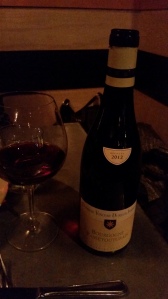What does being a wine nerd mean? Actually, what does being a nerd mean? If we define nerdery, then we can define wine nerdery as being simply the fact of presenting nerdlike attitudes to the subject of wine. The key word in the last sentence is “subject”, a nerd needs a subject to obsess about. Nerdery, at least the way I understand it, is different than passion. Passion is a strong desire, an overwhelming attraction for something whereas nerdery is a consuming desire to learn and know everything about a subject. I goes beyond liking something, there needs to be a thirst (see what I did here) for knowledge and lore, no matter obscure.
And there is a wine lore, undeniably. Actually, there are several wine lores; one could approach the subject matter through geography (the producing regions), science (the fermentation process), botany (grape varieties), law (bottling and labelling regulations)… There is a lot to know, there is a lot to learn, there is a lot to bore your friends with.
Personally, I like history, and there is a history lore of wine. Of course, mostly it consists of trends, underlying tendencies and slow processes rather than seminal events. There are however such events that helped shape the wine world. Once such event, known as the Judgment of Paris seems a good topic to bore you with today.

Judgment of Paris by Rubens
First of all, let’s mention the pun aspect. The judgment of Paris is the seminal event that caused the Trojan War, with the Trojan prince Paris finding in favor of Aphrodite against her fellow goddesses. In the wine world, it refers to a blind tasting event, held in Paris, on May 24th 1976, that pitted French wines around their US counterparts.
Eleven judges, nine from France, one from the UK and one American, blind tasted ten red wines and 10 white wines. The reds were all Cabernet-Sauvignon dominated blends, pitting top Bordeaux against top Napa Valley wines. The whites were all Chardonnays, this time pitting Burgundy against the Napa Valley. Remember, the year was 1976, so if you think French people are snobbish about non-French wines now, imagine how it must have been back then. Also, the grades given by the non-French judges were not counted, so the rankings are purely French-based.

Why did that tasting become a seminal, world changing event then? Well, because the US wines won. Stag’s Leap Wine Cellars dominated the red competition and Chateau Montelena won the white wine contest. Just to be thorough and drool a bit here were the line ups for each contest (ranked by result with their final score).
Red wines
Stag’s Leap Wine Cellars 1973, Napa Valley (127.5)
Château Mouton-Rothschild 1970 (126)
Château Haut-Brion 1970 (125.5)
Château Montrose 1970 (122)
Ridge Cabernet Sauvignon ’Mountain Range’ (Montebello) 1971, Santa Cruz Mts. (105.5)
Château Leoville-Las-Cases 1971 (97)
Mayacamas 1971, Napa Valley/Mayacamas Mts. (89.5)
Clos Du Val 1972, Napa Valley (87.5)
Heitz Cellars ’Martha’s Vineyard’ 1970, Napa Valley/St. Helena (84.5)
Freemark Abbey 1969, Napa Valley/Rutherford (78)
White wines
Chateau Montelena 1973, Napa Valley/Calistoga (132)
Meursault-Charmes 1973, Roulot (126.5)
Chalone Vineyards 1974, Monterey County/Soledad (121)
Spring Mountain 1973, Napa Valley/Spring Mountain (104)
Beaune Clos des Mouches 1973, Joseph Drouhin (101)
Freemark Abbey 1972, Napa Valley/Rutherford (100)
Batard-Montrachet 1973, Ramonet-Prudhon (94)
Puligny-Montrachet 1972, Les Pucelles, Domaine Leflaive (89)
Veedercrest 1972, Napa Valley/Mt. Veeder (88)
David Bruce 1973, Santa Cruz Mts. (42)
Of course this constituted a big surprise, there were controversy, protests, endless discussions about what it really meant. In the end, it did not matter, the result was that American wines were put on the map and I believe it’s a good thing. There is a movie about the event, it’s called Bottleshock and I plan to watch it soon. The question is rather, why did I decide to write about this now?

Well, it just so happens that last week, I was lucky enough to share a bottle of the Chateau Montelena Chardonnay with some friends. It wasn’t the 1973 vintage of course, it was a 2011, which in a way is good because, like the vintage used in the competition, it was 3 years old when drank. It is a fantastic wine, crisp, with aromas ranging from tropical fruits to citrus while still sampling some peach along the way, great balance and acidity. One of the best wines I had all year. The price also doesn’t hurt, you can find it for around $50 which for a “star” wine is a bargain. For instance another wine from the contest, the Puligny Montrachet Les Pucelles from Leflaive, will cost you around $200 for a bottle of 2011. I’d rather have the Montelena, thank you! It’s not often you can sample a wine that actually made history, or even just a wine that is famous. Price tends to be prohibitive for these bottles, and it is okay, it makes them even more special. An affordable, historic, great wine is something to celebrate though. This nerd will continue looking for wine knowledge, especially if it’s that tasty.


















